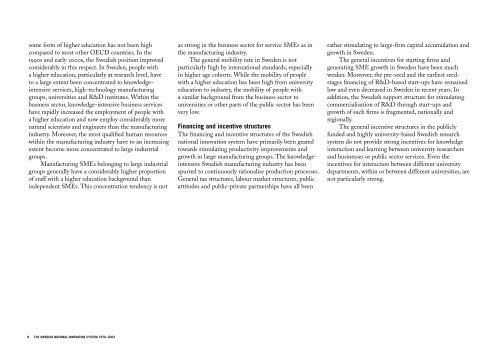The Swedish National Innovation System 1970-2003 - Vinnova
The Swedish National Innovation System 1970-2003 - Vinnova
The Swedish National Innovation System 1970-2003 - Vinnova
Create successful ePaper yourself
Turn your PDF publications into a flip-book with our unique Google optimized e-Paper software.
some form of higher education has not been high<br />
compared to most other OECD countries. In the<br />
1990s and early 2000s, the <strong>Swedish</strong> position improved<br />
considerably in this respect. In Sweden, people with<br />
a higher education, particularly at research level, have<br />
to a large extent been concentrated to knowledgeintensive<br />
services, high-technology manufacturing<br />
groups, universities and R&D institutes. Within the<br />
business sector, knowledge-intensive business services<br />
have rapidly increased the employment of people with<br />
a higher education and now employ considerably more<br />
natural scientists and engineers than the manufacturing<br />
industry. Moreover, the most qualified human resources<br />
within the manufacturing industry have to an increasing<br />
extent become more concentrated to large industrial<br />
groups.<br />
Manufacturing SMEs belonging to large industrial<br />
groups generally have a considerably higher proportion<br />
of staff with a higher education background than<br />
independent SMEs. This concentration tendency is not<br />
as strong in the business sector for service SMEs as in<br />
the manufacturing industry.<br />
<strong>The</strong> general mobility rate in Sweden is not<br />
particularly high by international standards, especially<br />
in higher age cohorts. While the mobility of people<br />
with a higher education has been high from university<br />
education to industry, the mobility of people with<br />
a similar background from the business sector to<br />
universities or other parts of the public sector has been<br />
very low.<br />
Financing and incentive structures<br />
<strong>The</strong> financing and incentive structures of the <strong>Swedish</strong><br />
national innovation system have primarily been geared<br />
towards stimulating productivity improvements and<br />
growth in large manufacturing groups. <strong>The</strong> knowledgeintensive<br />
<strong>Swedish</strong> manufacturing industry has been<br />
spurred to continuously rationalise production processes.<br />
General tax structures, labour market structures, public<br />
attitudes and public-private partnerships have all been<br />
rather stimulating to large-firm capital accumulation and<br />
growth in Sweden.<br />
<strong>The</strong> general incentives for starting firms and<br />
generating SME growth in Sweden have been much<br />
weaker. Moreover, the pre-seed and the earliest seedstages<br />
financing of R&D-based start-ups have remained<br />
low and even decreased in Sweden in recent years. In<br />
addition, the <strong>Swedish</strong> support structure for stimulating<br />
commercialisation of R&D through start-ups and<br />
growth of such firms is fragmented, nationally and<br />
regionally.<br />
<strong>The</strong> general incentive structures in the publicly<br />
funded and highly university-based <strong>Swedish</strong> research<br />
system do not provide strong incentives for knowledge<br />
interaction and learning between university researchers<br />
and businesses or public sector services. Even the<br />
incentives for interaction between different university<br />
departments, within or between different universities, are<br />
not particularly strong.<br />
8 THE SWEDISH NATIONAL INNOVATION SYSTEM <strong>1970</strong>–<strong>2003</strong>

















